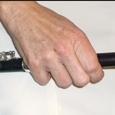Winter is a difficult time of the year for wooden instruments. However, performing in an overly air-conditioned hall in the summer causes problems too. No matter the temperature conditions, the bottom line is the same. How do we keep the wood from cracking? One of the most helpful things a player can do is to play the instrument daily. Consistent daily playing time keeps the instrument more tempered, and the wood in good condition as it receives the humidity from the breath used in playing.
When traveling to rehearsals, keep the instrument inside a well-protected case and case cover. Some case covers are lined with fleece or an insulating material that helps protect the piccolo from extreme temperatures. Most players carry their piccolos in gig bags which are also lined with several layers of temperature mitigating fabrics, including Mylar (the shiny aluminum colored fabrics used to make space blankets.)
Once inside the concert hall, unpack the piccolo and hold it in your hands or against your body for a few minutes to bring the temperature of the wood up a bit before beginning to play. (An oboist colleague warms up each of the three joints of the oboe separately before beginning to play.) The goal is to keep the entire instrument, inside and out, near the same temperature. Of course the breath naturally warms up the inside of the instrument as you play.
When performing, try to keep the piccolo warm between one entrance and the next. If there is too great of a difference in temperature from the ambient room temperature to the wood’s temperature, a water bubble can form and seal the tone hole open even though the key has not been depressed.
The difference in the temperature of the player’s breath (98.6 degrees) and the temperature of the concert hall (67 degrees) may cause the player’s breath to condense and form moisture. This moisture can be swabbed away during a rest, but if left to pool in the bore of the piccolo, it can fill an entire tone hole and prevent the key from opening fully. Some players silently blow into a cold piccolo to warm it up quickly. Quick-blowing into the piccolo increases the risk of creating extra condensation inside the instrument. It is better to keep the piccolo warm externally between entrances, so warming it up with the breath is unnecessary.
The most physically vulnerable part of the piccolo is the bulb where the wood curves out to go over the metal tenon work on the interior of the piccolo. This is where cracks are likely to occur, although they can happen anyplace on the wood surfaces.
One option to keep the piccolo warm is to use your hand to cover the majority of the headjoint when resting between entrances.

Another option is to keep the instrument tucked against your side between the arm and body.

Many male piccolo players tuck the piccolo into the pocket of their tuxedo jackets to keep it warm. If you do this, be sure the seams of the pocket are secure, as more than one piccolo player has seen his piccolo fall to the floor.
When your piccolo is on a stand, use a commercially made fabric sleeve that covers the entire piccolo to protect the instrument from drafty environments.
Learning to keep your piccolo warm in all climate conditions will help you on your way to successful piccolo performances.






